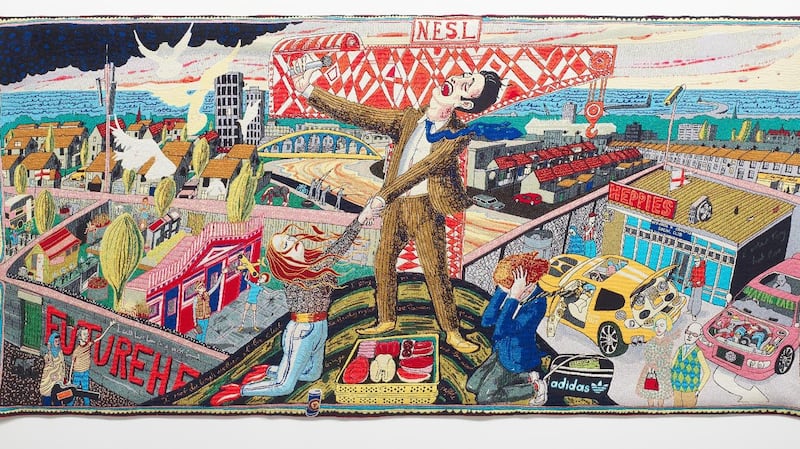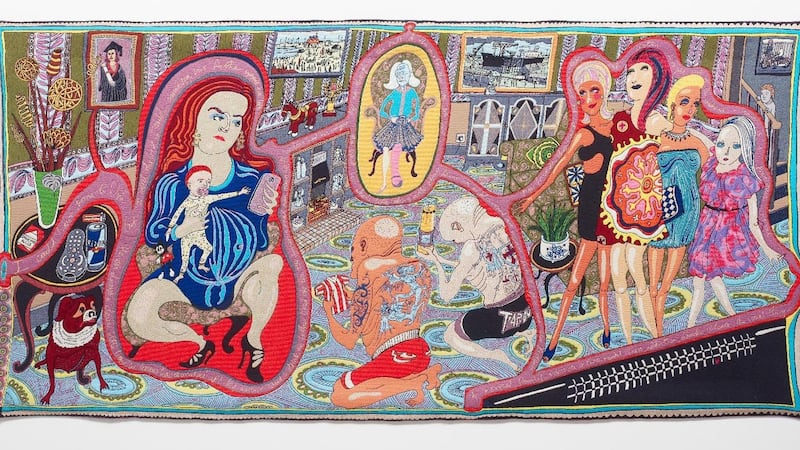Grayson Perry's The Vanity of Small Differences ★★★★
Six tapestries by Grayson Perry, RHA Galleries, Ely Place, Dublin, Until March 19, rhagallery.ie
Grayson Perry, who initially achieved fame as the transvestite potter, is an unlikely pillar of the establishment, but there's something quintessentially English about him, in a deep, folksy, Pearly Kings and Queens, Morris dancing, Carry On kind of way, as an acceptable transgressive presence, a necessary cultural vent for the intolerable tensions of being forever strong and stable. He is now, though, Grayson Perry CBE, a Turner Prize-winning, internationally feted artist who wrote and delivered the BBC Reith Lectures for 2013.
He wears his respectability as lightly as the dresses he – and many others – design for his female alter ego, Claire. Unlike an actor who might submerge himself in a role – Daniel Day Lewis, say – Perry’s performances are all about himself, even though that self is displaced on to Claire or other invented personas. But a large part of his charm is that he manages to be perpetually self-obsessed without being annoyingly egotistical.
He’s observant, omnivorously curious, enthusiastic and creatively energetic, and he has a political consciousness – and conscience. Who could be better placed to dissect the social mores of English society early in the 21st century?

About 2012, to narrow it down, during a pre-Brexit vote era that may, who knows, be seen as comparable in retrospect to the lull before the storm of the first World War a century previously. With an allusion to Freud's phrase on oneupmanship, "the narcissism of minor differences", Perry's The Vanity of Small Differences is a series of tapestries loosely inspired by William Hogarth's morality tale in paintings, A Rake's Progress. The work came about in relation to the Channel 4 documentary series All in the Best Possible Taste.
Class spectrum
Visiting Sunderland (working class, industrial), Tunbridge Wells (conservatively middle class) and the Cotswolds (landed gentry) and interviewing people across the class spectrum along the way, Perry amassed a reference-bank of their tastes and preferences as expressed in the form of cars, carpets, wallpaper, furniture, food, gadgets, books, clothes, hairstyle, pets, pictures and the generality of décor and possessions.
All of which function as signifiers, not of individuality as people might like to imagine, but of class identity and social aspirations. “Class is something bred into us like a religious faith,” as he puts it.

Across six large tapestries, each two by four metres, he proceeds to deploy this information as a gaudy inventory of telling visual references, from iPhones to Jamie Oliver, in the invented tale of Tim Rakewell who progresses from rags to computer software riches to disaster when, showing off, he wraps his Ferrari around a lamppost.
Like Perry himself, Rakewell is rejected by his dysfunctional family and rises dramatically in a world of relentless consumerist display. Perry gleefully anatomises the materialism of contemporary society while retaining a level of sympathy, and empathy, for his cast of hapless characters. Perry, who had used tapestry previously, with success, opted for the medium because it has been traditionally been associated with wealth and the aristocracy. He presumably provided the cartoons, from which the tapestries were woven in Holland. The intensity of the textile colours lend a sumptuousness to his appropriately garish palette, and the images are dense with narrative detail. His graphic style is one of broad caricature that, writ large, can seem overblown. Among his innumerable achievement, he has a graphic novel to his credit, and each frame in the Vanity story would read well on the scale of a printed page.
Primary source
His primary source was William Hogarth's 18th-century sequence of eight narrative paintings, A Rake's Progress, one of his "modern moral subjects", produced early in the 1730s and popularised through a series of engravings. Socially progressive, Hogarth had apprenticed as an engraver, but it's fair to say that his engravings were not cheap and generally affordable. Such is his fame as an engraver that he can be underrated as a painter, and he was a superb painter.
In A Rake's Progress his protagonist, Tom Rakewell, inherits a fortune, dumps his pregnant fiancée, becomes a profligate, careless man about town, marries for money, which he proceeds to gamble away, and is dispatched to a debtors' prison – as happened to Hogarth's own father when his business failed – and, eventually, a mental asylum.
Hogarth's Rake inspired a catalogue of successors, including David Hackney's print series, A Rake's Progress, based on his visit to New York in 1961, and Yank Honiara's elaborately staged Diary of a Victorian Dandy from 1998.
Perry doesn't stick closely to Hogarth's template and introduces a range of additional pictorial references, notably drawn from religious art of the early Renaissance. Masaccio, Grunewald, Jan Van Eyck and Gainsborough (with Rakewell and his wife as Gainsborough's Mr and Mrs Andrews) are among those acknowledged.

Despite the conspicuous baling of the constructed worlds the characters inhabit, there is a distinct undercurrent of decline, of a kind of post-industrial malaise. A sense of decay is even more overt in The Upper Class at Bay, with the aristocracy visualised as aimless guardians of an empty heritage and a lost past.
Convention
Perry won the Turner Prize for his pioneering ceramics. He managed to transform the possibilities of the medium by ignoring convention and using it straightforwardly to reflect his own personality. He has, since then, transcended the Turner and any other labels restricting him to the contemporary art world, becoming a sort of national treasure.
Acceptance is interesting, he mentioned to Michael Berkeley recently in a radio interview. Walking along the street one day, a workman surfaced from a trench on the roadway beside him and looked him up and down as recognition dawned. “Shouldn’t you be wearing a dress?” he remarked, neutrally.












